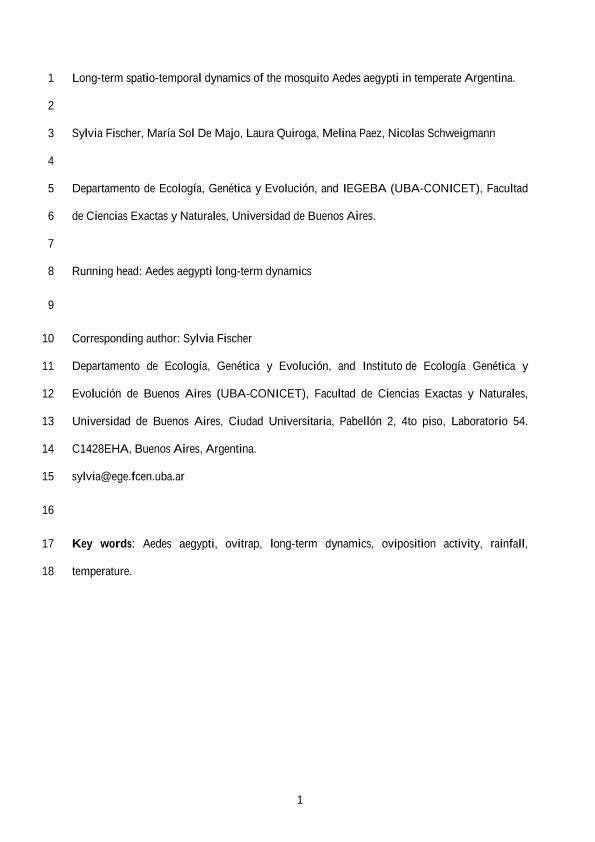Artículo
Long-Term spatio-Temporal dynamics of the mosquito Aedes aegypti in temperate Argentina
Fischer, Sylvia Cristina ; de Majo, María Sol
; de Majo, María Sol ; Quiroga, Laura; Paez, Melina; Schweigmann, Nicolas Joaquin
; Quiroga, Laura; Paez, Melina; Schweigmann, Nicolas Joaquin
 ; de Majo, María Sol
; de Majo, María Sol ; Quiroga, Laura; Paez, Melina; Schweigmann, Nicolas Joaquin
; Quiroga, Laura; Paez, Melina; Schweigmann, Nicolas Joaquin
Fecha de publicación:
04/2017
Editorial:
Cambridge University Press
Revista:
Bulletin of Entomological Research
ISSN:
0007-4853
Idioma:
Inglés
Tipo de recurso:
Artículo publicado
Clasificación temática:
Resumen
Buenos Aires city is located near the southern limit of the distribution of Aedes aegypti (Diptera: Culicidae). This study aimed to assess long-Term variations in the abundance of Ae. aegypti in Buenos Aires in relation to changes in climatic conditions. Ae. aegypti weekly oviposition activity was analyzed and compared through nine warm seasons from 1998 to 2014, with 200 ovitraps placed across the whole extension of the city. The temporal and spatial dynamics of abundances were compared among seasons, and their relation with climatic variables were analyzed. Results showed a trend to higher peak abundances, a higher number of infested sites, and longer duration of the oviposition season through subsequent years, consistent with a long-Term colonization process. In contrast, thermal favorability and rainfall pattern did not show a consistent trend of changes. The long-Term increase in abundance, and the recently documented expansion of Ae. aegypti to colder areas of Buenos Aires province suggest that local populations might be adapting to lower temperature conditions. The steadily increasing abundances may have implications on the risk of dengue transmission.
Archivos asociados
Licencia
Identificadores
Colecciones
Articulos(IEGEBA)
Articulos de INSTITUTO DE ECOLOGIA, GENETICA Y EVOLUCION DE BS. AS
Articulos de INSTITUTO DE ECOLOGIA, GENETICA Y EVOLUCION DE BS. AS
Citación
Fischer, Sylvia Cristina; de Majo, María Sol; Quiroga, Laura; Paez, Melina; Schweigmann, Nicolas Joaquin; Long-Term spatio-Temporal dynamics of the mosquito Aedes aegypti in temperate Argentina; Cambridge University Press; Bulletin of Entomological Research; 107; 2; 4-2017; 225-233
Compartir
Altmétricas



